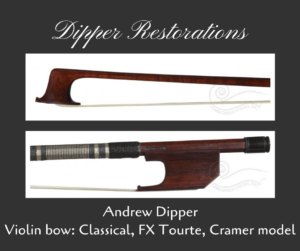
The Cramer bow is distinctive because of its ‘battle axe’ head profile. It came into use in the court orchestras of Mannheim, Munich and Dresden after 1760, where it became synonymous with the dynamic Mannheim style of orchestration and performance. It supplanted the Italian model of Tartini, whose design was typified by a somewhat awkward and rather fragile swan head with a long tip.
The Tartini bow rose to prominence between 1730-1760 and its design was specially formulated to produce skillful manipulations of tone on the Neapolitan gut strings that were then in use amongst the acolytes of Tartini. At the beginning of the 1800’s the general use of this bow was eased out of fashionable circles by the finely crafted bows of the Tourte design that featured a wider and flatter hair ribbon and frogs with metal fittings and mother-of-pearl decorative motifs plaques and inlays.
The Cramer bow, on the other hand fitted a different musical use and was designed for volume dynamics and percussive attack techniques of large ensembles, techniques that might have compromised the somewhat weaker and elevated heads of the Tartini models. It was promoted and in fashion between 1760-1785 notably in Manheim where Wilhelm Cramer spent the early portion of his career, and in London where Cramer emigrated in 1772. Many makers of the period made their own interpretation of the Cramer model. F. Tourte and the English Dodd family made notable advances in its design until It faded from use and was displaced by the common modern bow after 1830.
The Cramer model bow is longer than most Italian models, measuring around 70-71 cm but is shorter than the modern standard length of around 74.5cm. Interestingly in some cases the early models of this bow had sticks that were partially fluted, a feature that increases the flexibility of the stick and reduces its weight while maintaining its strength and flexibility . It is notable that this rare detail implies an evolutionary connection with the fluted snakewood baroque bows of the 1700-1760 period. Styles varied in their fine details and weights rose gradually from 55 grams or less to 57 grams or more. Many were made of dense and heavy rare tropical hardwoods and the area of inherent weakness in the short grain where the head meets the stick seems thin and fragile in early examples. The head design becomes much more robust in later ones, particularly in those from England made by the Dodd family. Some of the Cramer pattern bows were fitted with finely profiled ivory frogs that have a characteristic floral pattern cut out at their front and rear. I presume that these over decorative examples were intended as part of the accoutrements of the court orchestras, since their decoration matches the designs of the embroidered floral patterns some of the court uniforms that were then in fashion.
A notable characteristic of the Cramer model is the specially shaped head whose design incorporates a thin palette of wood that extends the back of the tip plate towards the bow frog, giving the design its familiar battle axe profile. This detail lends strength to the back of the head behind the hair mortise and players have noted that this feature aids immediacy of the response to the bow in spiccato strokes. From a maker’s point of view this novel head design seems intended to maximize the strength of the bow. An analysis of the design suggests that it does this by shifting the point load from the area immediately behind the bow head, moving it rearwards toward the frog. In some historic examples that I have measured there is a flex point, around 3-4 cm behind the head that shows a notable but subtle thicknessing pattern, seemingly intended to damp percussive shocks that might otherwise break off the head of the bow. The appearance of the Cramer bow seems therefore to be linked to a special use in large orchestras assembled for large venues with potentially rowdy audiences. Contemporary accounts of the public performances by large orchestras in Mannheim, London and Paris of the period support this idea.
The famous bow collector and violinist Michael Woldemar records that the type of bow used by Viotti was similar in head design from the Cramer bow but lacked the palette extension at the rear of the head mortise. The Cramer bow is furnished with a significantly lighter hair ribbon than the modern bow and the ribbon has a camber to it shaped by the track in the bow frog. The Individual hairs are lighter in weight and thinner in diameter than the standard modern ones, which preserves the overall delicacy of the design. The bows typically weigh less than the modern standard, being in the 50-57 gram range, a weight that includes the hair tensioning mechanism and the special silk and tinsel wrap. The tensioning mechanisms of the original bows are precise and are normally, in the French models, fitted with an iron screw with swaged thread and brass or bronze eyelet.


